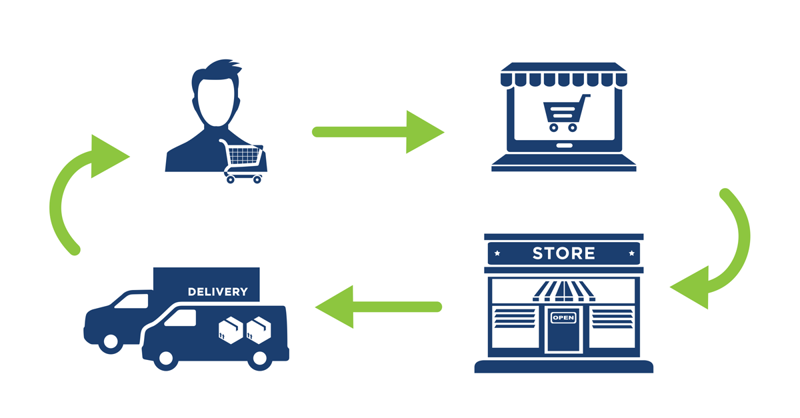Retailers looking to capitalize on the booming growth of online shopping are increasingly taking an omnichannel approach to their supply chains. Perhaps, the one place they have the biggest edge over pure-play eCommerce businesses is the ability to leverage their brick-and-mortar footprint for quicker and cheaper shipping options using a ship-from-store strategy.
According to a report in Modern Shipper, the 2020 holiday season in the U.S., saw the proportion of online sales supported by physical stores rise to 37%, a jump from 32% in 2019, according to GlobalData. Picking up online orders from stores, either BOPIS or curbside, grew by 103% last year, while retailers shipping from stores as part of their omnichannel strategy grew by 80%
A recent report from Allied Market Research showed that The global same-day delivery market was valued at $5.78 billion in 2019, and is expected to reach $20.36 billion by 2027, for a 21.1% CAGR.
While retail sales are still strong, with the National Retail Federation (NRF) anticipating the number to top $3.8 trillion this year, most traditional brick-and-mortar locations are trying to adapt their square footage as the cost of space adds up while shoppers continue to split time between making a trip to the store and shopping via the internet – increasingly while on the go. In fact, eMarketer forecasts that mobile commerce will account for 72.9 percent of global retail eCommerce sales by 2021.
The retail market continues to grow and online retail only represents less than 15 percent of the total market so there is plenty of opportunity for growth. Brick-and-mortar retailers don’t have a market potential problem, they have a real estate problem. Ship-from-store is an opportunity for brick-and-mortar retailers to convert expensive storefronts into distribution centers, cutting the costs of warehousing products farther away from the customer base. Additionally, whether a retailer is local, regional, or national, they double their reach to customers by being able to service walk-in shoppers as well as extending the reach of their eCommerce platform.
A New Day for Same-Day
Leading the charge for ship-from-store is the increasing demand for speedy delivery. In today’s want-it-now instant gratification society, customers are less willing to wait for their items to show up at the door. There was a time when two-day delivery would do. Then one-day. Now, as grocery stores and others cut delivery times to mere hours, consumers expect the same – or at least close – regardless of where and what they are purchasing. Retailers that can deliver will gain a competitive advantage over those that can’t.
In fact, 39 percent of consumers say same-day shipping would make them more likely to shop online, and 20 percent are looking for two-hour (or less) shipping, according to “The Future of Retail 2019,” a study published by Walker Sands, a full-service B2B marketing agency.
And that is expected to continue to grow both the number of orders and the all-important ticket sizes as 72 percent of shoppers would shop more and spend more if same-day delivery were available, according to a report in PARCEL magazine.
Additionally, a 2018 Small Business Trends infographic indicated as many as 65 percent of retailers globally offered some form of same-day delivery, with 88 percent of consumers willing to pay something for that delivery, turning it into a possible profit center or at least mitigating its cost.
Despite this growing demand, those using a more traditional supply chain with centralized warehouses and distribution centers will continue to find themselves playing catch-up to those incorporating an omnichannel shipping approach as 77 percent of warehouses said that delivering products on the same day is their biggest challenge, according to the PARCEL Magazine report.
In the same-day delivery arena, physical locations available for ship-from-store logistics that incorporate powerful enterprise shipping software to help manage shipping from one to 1,000 locations or more, as well as a bevy of local carriers, are the ones that will not only survive but thrive.
